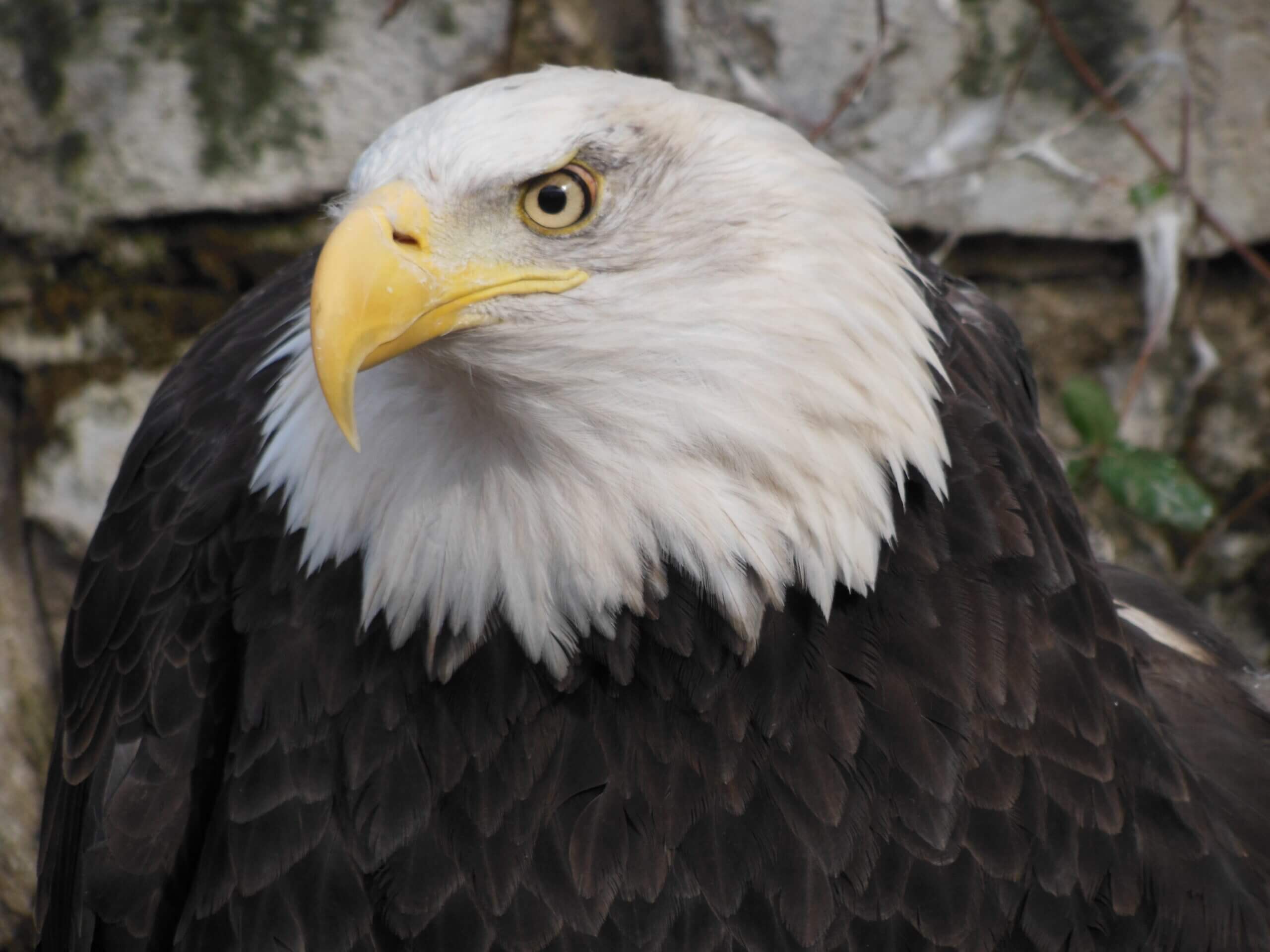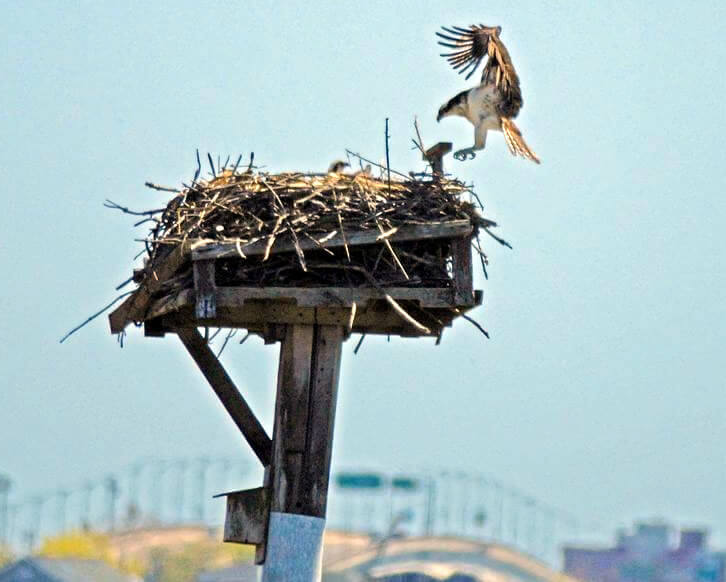Bald Eagle
Peregrine Falcon
Osprey
American Kestrel
Raptors, commonly referred to as “birds of prey,” include hawks, owls, eagles, falcons and vultures. Raptors have fascinated people for thousands of years and inspire people even today. Fortunately, after some frightening declines in some of our largest species, raptors represent some of New Jersey’s greatest success stories.
The bald eagle, osprey, and peregrine falcon have made impressive comebacks from the brink of extinction, in large part thanks to the efforts of NJ Fish and Wildlife biologists. Unfortunately, not all species of raptors are thriving; the American kestrel, for instance, has experienced a sharp decline since the 1990s, and its population is under investigation by biologists in the Endangered and Nongame Species Program.
Bald Eagles
The bald eagle is a shining example of a wildlife success story in New Jersey. In 1973, when the Endangered and Nongame Species Conservation Act was passed, there was just one nesting pair, located in a remote forest in Cumberland County.
In 2023, there were 255 nesting pairs of eagles in the state. About half of those nests are in the Delaware Bay counties of Cumberland and Salem, but eagles can now be found in all 21 counties. In winter, NJ supports both resident and migrant eagles that rely on the open waters of rivers, lakes, and bays for survival. Eagles remain on the state endangered species list due to their sensitivity to environmental contaminants, habitat loss and human disturbance. The challenge to biologists and citizens now is protecting the lands and waterways used by eagles to maintain and enhance this species’ recovery.
Volunteer Opportunity! The Endangered & Nongame Species Program (ENSP) employs volunteers who monitor Bald Eagle nests in New Jersey. We have volunteer opportunities now in Salem and Cumberland counties. Being a nest monitor entails checking a specific nest every 1-2 weeks for about an hour at a time, during the nesting season of January through July. The goal is to record key information about each nest: when the pair is nest-building, when they lay eggs and begin incubation, when the eggs hatch, and the number of chicks seen and fledged. Other information on disturbances to the eagles or unusual behaviors is important because it may help interpret the nest outcome. The ENSP offers training and materials. Data on nests is entered in an online format for immediate use by biologists. Contact: Kathy.Clark@dep.nj.gov. Please provide your location of interest.
2024 Eagle Report (pdf, 3.56mb)
2023 Eagle Report (pdf, 4.04mb)
2022 Eagle Report (pdf, 2.1mb)
2021 Eagle Report (pdf, 6.69mb)
2020 Eagle Report (pdf, 2.4mb)
2019 Eagle Report (pdf, 1.2mb)
2018 Eagle Report (pdf, 5.2mb)
2017 Eagle Report (pdf, 940kb)
2016 Eagle Report (pdf, 735kb)
2015 Eagle Report (pdf, 850kb)
2014 Eagle Report (pdf, 970kb)
2013 Eagle Report (pdf, 345kb)
2012 Eagle Report (pdf, 520kb)
2011 Eagle Report (pdf, 380kb)
2010 Eagle Report (pdf, 535kb)
2009 Eagle Report (pdf, 430kb)
2008 Eagle Report (pdf, 362kb)
2007 Eagle Report (pdf, 163kb)
2006 Eagle Report (pdf, 573kb)
2005 Eagle Report (pdf, 260kb)
2004 Eagle Report (pdf, 138kb)
2003 Eagle Report (pdf, 129kb)
2002 Eagle Report (pdf, 380kb)
2002 Eagle Update
2001 Eagle Report (pdf, 120kb)
2000 Eagle Report (pdf, 245kb)
1998 Eagle Report
1997 Eagle Report (pdf, 40kb)
Duke Farms Eagle Cam (Conserve Wildlife Foundation of NJ)
Bald Eagles with Supervising Zoologist Kathy Clark (DEP Podcast, 1/27/17)
The Last Nest: Saving Our Bald Eagle Population (njmonthly.com, 1/27/16)
Peregrine Falcons
The peregrine falcon, as the fastest bird in the skies, has fascinated people for centuries. Peregrine numbers fell due to the effects of DDT that caused their eggs to fail, and they became extinct east of the Mississippi by 1964. They were one of the first birds to be the focus of conservation, however, and through an intensive reintroduction program, returned to the skies in New Jersey and other eastern states in the 1980s.
The population in New Jersey has been about 30-35 pairs annually since 2010. In 2003 peregrine falcons recolonized their historic cliff nesting habitat on the Hudson River Palisades – a huge milestone in the peregrine’s recovery in the state and the region. It is also exciting to see peregrines take advantage of tall buildings where they nest in cities, adding a touch of wildness to urban scenes!
2024 Peregrine Falcon Report (pdf, 754kb)
2023 Peregrine Falcon Report (pdf, 913kb)
2022 Peregrine Falcon Report (pdf, 622kb)
2021 Peregrine Falcon Report (pdf, 835kb)
2020 Peregrine Falcon Report (pdf, 1.2mb)
2019 Peregrine Falcon Report (pdf, 1.3mb)
2018 Peregrine Falcon Report (pdf, 630kb)
2017 Peregrine Falcon Report (pdf, 300kb)
2016 Peregrine Falcon Report (pdf, 280kb)
2015 Peregrine Falcon Report (pdf, 100kb)
2014 Peregrine Falcon Report (pdf, 130kb)
2013 Peregrine Falcon Report (pdf, 145kb)
2012 Peregrine Falcon Report (pdf, 135kb)
2011 Peregrine Falcon Report (pdf, 155kb)
2010 Peregrine Falcon Report (pdf, 255kb)
2009 Peregrine Falcon Report (pdf, 113kb)
2008 Peregrine Falcon Report (pdf, 136kb)
2007 Peregrine Falcon Report (pdf, 67kb)
2006 Peregrine Falcon Report (pdf, 34kb)
2005 Peregrine Falcon Report (pdf, 34kb)
2003 Peregrine Falcon Report (pdf, 20kb)
2002 Peregrine Falcon Report (pdf, 47kb)
2001 Peregrine Falcon Report (pdf, 18kb)
2000 Peregrine Falcon Report (pdf, 57b)
Union County Falcon Cam – Conserve Wildlife Foundation of NJ site
Burlington County Bridge Cams – Nests on Burlington-Bristol and Tacony-Palmyra bridges
Reestablishment of Peregrine Falcons on Lower Hudson River Cliffs (pdf, 200kb) – New Jersey Audubon Society Publication, 2009
Establishment and Growth of the Peregrine Falcon Breeding Population Within the Mid-Atlantic Coastal Plain (pdf,165kb)
Ospreys
Ospreys are well-loved birds of our coastal bays and marshes. Formerly known as the fish hawk, ospreys rely almost exclusively on fish for their diet. They, like eagles and falcons, suffered the effects of DDT and their population dropped to about 60 pairs by the early 1970s. During their population decline, coastal development soared and many trees formerly used for nesting disappeared. Their population recovery was supported by various human structures like channel markers and duck blinds, but especially the nest structures provided for them by biologists and citizen advocates.
With the help of people who installed and continue to maintain nest structures, ospreys have recovered to more than 700 nesting pairs, which is likely to be their pre-DDT population size. The Endangered and Nongame Species Program monitors their population as an indicator coastal environmental health, because ospreys are sensitive to contaminants and the viability of the aquatic food chain. Citizens are invited to contribute data on osprey nests online at www.osprey-watch.org.
2023 Osprey Report (pdf, 1.82mb)
2022 Osprey Report (pdf, 2.25mb)
2021 Osprey Report (pdf, 2.34mb)
2020 Osprey Report (pdf, 3.2mb)
2019 Osprey Report (pdf, 3.8mb)
2018 Osprey Report (pdf, 830kb)
2017 Osprey Report (pdf, 620kb)
2016 Osprey Report (pdf, 900kb)
2015 Osprey Report (pdf, 240kb)
2014 Osprey Report (pdf, 105kb)
2013 Osprey Report (pdf, 115kb)
2012 Osprey Report (pdf, 77kb)
2011 Osprey Report (pdf, 75kb)
2010 Osprey Report (pdf, 179kb)
2009 Osprey Report (pdf, 158kb)
2008 Osprey Report (pdf, 151kb)
2007 Osprey Report (pdf, 48kb)
2006 Osprey Report (pdf, 44kb)
2005 Osprey Report (pdf, 52kb)
2004 Osprey Report (pdf, 43kb)
2003 Osprey Report (pdf, 21kb)
2002 Osprey Report (pdf, 43kb)
Osprey Fact Sheet (pdf, 50kb)
Osprey Nest Platform Plans and Placement Information
Living With Osprey: A guide for the removal, relocation, and placement of osprey nests (pdf, 800kb)
American Kestrels
This once-common inhabitant of fallow fields and pastures has declined since 2000, and the reasons are largely unknown. In 2012, NJ listed the American kestrel as a State Threatened species. The Endangered & Nongame Species Program has a nest-box program to both support local populations and study reproductive parameters such as nest occupancy, hatching success, and causes of failures. Biologists band kestrels to obtain information on their survival, dispersal, and return to NJ nest sites.
2004 American Kestrel Survey (pdf, 334kb) The Endangered and Nongame Species Program embarked on a survey campaign in 2004, and the findings were alarming.
In 2006, ENSP collaborated with Dr. John Smallwood of Montclair University, and one result was an article in the Journal of Raptor Research, American Kestrel breeding habitat: The importance of patch size (pdf, 375kb). This research found that kestrels select large patches of suitable habitat (>2,400 acres), more than smaller patches, for nesting, which may be important for their ultimate population recovery. Current research is focusing on contaminants that may affect kestrels, and documenting the types and abundance of foods they rely on in different areas in NJ.

In 2019 ENSP began a multi-year camera monitoring system to document prey deliveries to kestrel nest boxes to better understand the nutritional needs of nestlings and why some nest boxes perform better than others, despite similar occupancy rates each year.
In 2021, the camera system documented the emergence of the Brood X periodical cicadas along the border of Hunterdon and Mercer Counties in New Jersey. The cameras chronicled how adult kestrels shifted prey deliveries, taking advantage of this readily available resource. Video data demonstrated how this abundant food source led to increases in nest box success, productivity, and nestling weights.
American Kestrels Capitalize on Cicada Emergence (pdf)
Volunteer Opportunity! Kestrel nest boxes are established in agricultural areas across New Jersey, and the Endangered and Nongame Species Program enlists volunteers to adopt and monitor a nest box “route” each spring from April through July. Each route includes roughly a dozen boxes, which take 3-5 hours to monitor every 12-15 days. Nest boxes are mounted 10-15 feet off the ground on utility poles, trees and buildings, so volunteers should be comfortable climbing, carrying and transporting a ladder. Typical duties include adding fresh bedding, identifying nests and eggs found inside the nest boxes, removing European starling nests (a major competitor), recording data in the field and submitting updates online. Join us in banding Kestrel chicks from your successful nest box! Contact Bill Pitts at William.Pitts@dep.nj.gov or 856-629-5783.
Please report your sightings of this bird, especially in the breeding season (April – July) using the Sighting Report Form.
American Kestrel Fact Sheet (pdf, 70kb)
ADDITIONAL LINKS
 Official Site of The State of New Jersey
Official Site of The State of New Jersey






